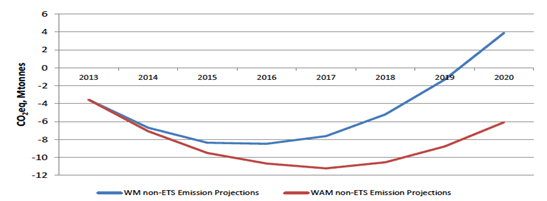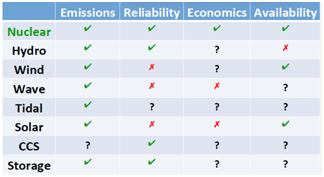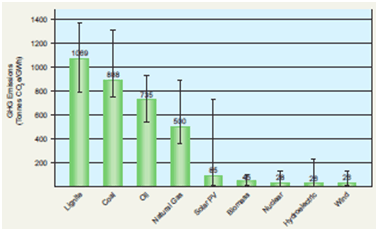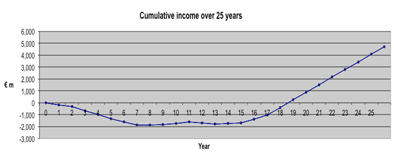Why Nuclear and why now?
In a move that may reflect our growing maturity as a nation, the current Green Paper on Energy Policy in Ireland questions our policy of ignoring the potential benefits that nuclear energy could bring to Ireland. The Green Paper recognizes the huge global threat posed by climate change and the threat to the national economy posed by increasing fossil fuel prices while accepting the useful but limited role that renewables could play in our energy future.
The question of nuclear energy arises now because the coal burning station at Moneypoint, which provided our most affordable baseload electricity since 1985, approaches its end of life by 2025. It is critical for our society and economy that we select its most appropriate replacement in terms of safety, emissions, reliability and affordability.
The Intergovernmental Panel on Climate Change (IPCC) clearly outlines the need to reduce greenhouse gas emissions significantly, leading to increasingly strict EU emissions targets. Figure 1, below, shows the EPA projection that Ireland will exceed our 2020 emissions target by up to 4 million tonnes at a cost of some €100 million – even if we fully implement everything we currently plan to do and despite our excellent renewable resources.

No existing low-emissions technology can easily replace Moneypoint’s reliable baseload output. Regular hydro power is effectively fully utilized in Ireland; wind energy is intermittent as it depends on the weather and so is unsuitable as a baseload supply; while emissions from gas-fired generation are excessive as they are almost half that from coal. Our current concentration on gas and renewables may be adequate to 2020, but thereafter we’ll require at least one other technology to lower emissions sufficiently at reasonable cost and with adequate reliability.

Some innovative solutions have been proposed but none are progressing as speculated. Of these, wave and tidal systems are extremely unlikely to reach even our target of 500 MW installed and they will be intermittent and expensive; large-scale pumped storage has made little effective progress since it was first mooted five years ago; and Carbon Capture and Storage systems are still unproven while the storage of captured gas in Ireland is now prohibited.
A recently proposed biomass solution requires detailed study to assess its suitability, however.
So now the Green Paper asks whether we should consider nuclear energy. Many significant Irish organisations (including EirGrid, ESB, Commission for Energy Regulation, Forfás, The Competitiveness Council, IBEC and ICTU) have called for nuclear to be considered here, as have a number of independent experts and all the national newspapers. In July 2014, the CEO of ESB said that he “didn’t disagree about it [the need to go nuclear] at all”. While he said that there is a case for nuclear on the island of Ireland only if the size of nuclear plants was to be appropriate for us, we explain below that suitably sized plants will be available before Moneypoint is retired.
Why consider nuclear energy now, given it has been contentious in Ireland since the 1970’s when ESB proposed a nuclear plant at Carnsore Point, Co Wexford? The argument was that nuclear power plants were not safe; they were too expensive and too big for Ireland; that we couldn’t build them and the waste is too dangerous.
The answer lies in the smaller modular reactors (SMRs) under development in the US and elsewhere. These advanced Generation 3 reactors address the most popular of the reservations people have about nuclear energy. At around 200 MW, SMRs are smaller than some of our existing generators and are ideal for Ireland.

Emissions: Nuclear has near-zero emissions as can be seen in Figure 3. A nuclear station the size of Moneypoint would save over 5 million tonnes of CO2 per year compared to coal and over 2.5 million tonnes compared to gas-fired combined cycle plant. Each of the low carbon options (solar, biomass, nuclear, hydroelectric and wind) should be assessed before deciding on our energy strategy for a sustainable future. This assessment is best conducted by an independent group of experts.
Safety: SMRs are based on nuclear submarine technology, which has an impeccable safety record. They incorporate the lessons learnt from earlier failures and have “passive safety”, making them even safer than existing reactors – no operator intervention is required for up to 14 days even if all backup power is lost. And they cannot explode like a nuclear bomb under any circumstances whatsoever.
Nuclear is the safest baseload power generation technology on an objective like-for-like comparison. This is reflected in the fact that there are more reactors planned or proposed now (482) than before the Fukushima accident (478). Even Belarus, which was impacted most by Chernobyl, is building its first two nuclear units with two more planned for around 2025.

Cost: SMRs can produce electricity for between 5 cent and 8.4 cent per unit, which is much cheaper than Britain’s 9 pence per unit from its new nuclear units. Figure 4 (from a Sustainable Energy Authority of Ireland report) shows how it is cheaper to reduce emissions using nuclear than using large amounts of onshore wind or using offshore wind, wave or tidal energy. Note that SMRs would reduce costs significantly compared to the nuclear plants used in the SEAI study.
Construction: While larger reactors often overrun their lengthy construction estimates, SMRs are built in factory and require minimal assembly on site, reducing build time to 3 years. Improved build reliability leads to improved project certainty, which greatly reduces project risk. This, in turn, lowers the cost of finance, which reduces the final cost of electricity.

By installing the units sequentially, the first SMR would be operating and earning income before the next is underway, thus reducing the total sunk capital requirement to levels affordable by privately owned utilities – no State investment or subvention would be required.
Waste: Under International agreements, such as proposed by the International Framework for Nuclear Energy Cooperation, Ireland would source its nuclear fuel from an existing nuclear nation to whom we would return all the spent fuel for safe storage or reprocessing.
Reliability: Nuclear reactors are typically available for over 90% of the time.
Compatibility: Cheaper power from SMRs can offset the higher cost of certain renewables. Crucially, like nuclear submarines, SMRs can change power output quickly to accommodate intermittent wind and solar energy, resulting in a clean, reliable, safe and affordable electricity supply.
Interconnector: Figure 6, below, outlines how we have imported 25 times more energy than we export, as wholesale prices are currently cheaper in Britain. Lower energy prices from Irish SMRs would allow us to export electricity, improve competitiveness in Ireland, improve our balance of payments and increase employment. It is also important to note that maintaining control of our electricity supply improves energy security.


Public opinion on nuclear energy in Ireland has not been sought comprehensively to date. Evidence of public support is clear from this May 2014 online poll asking whether the ban on nuclear power should be lifted – 59% were in favour with 35% against, from an admittedly small poll of 7,127 respondents. It is imperative that a comprehensive and unbiased assessment of public opinion is sought on the matter.
Objections: While nuclear energy is contentious, there is large public opposition in Ireland to almost every significant piece of proposed infrastructure including gas fields, wind turbines and electricity pylons. However, nuclear has one clear advantage over the others: it could be installed at an existing power station and use existing electricity transmission cables, concentrating the argument into a single location. This could avoid the type of expanding protests now being witnessed against wind turbine and grid expansion projects nationwide.
Political Instability: The increasing political instability in the Middle East and Russia will make it essential that Ireland diversifies its sources of energy as it is no longer certain that it will be able to obtain energy supplies from these regions in the foreseeable future. Nuclear energy would provide considerable independence from these regions and help ensure security of supply.
Siting: Moneypoint is just one of a number of suitable locations in Ireland, each of which could have a number of SMRs providing hundreds of high quality jobs in a safe and clean environment.
Opportunities: Local colleges could train nuclear engineers, operators, maintenance staff, environmental monitoring and protection staff and so on. Meaningful jobs could also be created in the areas of simulator training, foreign consultancy, civil defense, communication and marketing, finance and so on.
Local County Councils would benefit hugely from significant rates, secured for 60 years or more. There would also be many service jobs in these communities and the prosperity of the entire region would be enhanced by the presence of the SMR plant. National competitiveness would also receive a boost through lower guaranteed cost of power for businesses throughout Ireland.
The cost of not going nuclear: To illustrate the long-term effects of national energy policy decisions, consider the cases of Ireland and Finland. Both these countries proposed the Nuclear Non-Proliferation Treaty in the 1960’s and were the first signatories of this treaty when it came into being in 1968. Within 12 years, Ireland had rejected nuclear power generation while Finland adopted it.
Now, Finland has a balanced portfolio of fuels in its generation mix, producing around 30% from each of nuclear, hydro and coal, with the remainder mainly coming from gas. Ireland, on the other hand, has over 60% from gas, 15% from renewables and the remainder is from coal and peat. As a result, Finland emits only marginally more CO2 per head of population than Ireland while using twice as much energy as us.
Critically, electricity is 50% more expensive for Irish households and 100% more expensive for Irish industry than for their Finnish counterparts. This is a clear and practical illustration of the economic and environmental benefits that Ireland is passing up with its current prohibition of nuclear power.
The way forward
Ireland will need a mix of generating technologies including renewables, gas and nuclear to keep energy affordable while meeting our environmental targets. To help achieve this, we should study the potential of nuclear energy, and particularly SMRs, without delay.
We should also repeal the current legislation that precludes us from using nuclear energy.
There is a tremendous potential opportunity for Ireland to take full commercial advantage of being the first European nation to deploy small nuclear reactors while moving further towards a low emissions, lower cost energy supply.
Rather than being seen as a threat, nuclear energy can work to our advantage. The time to consider whether we want to seize this opportunity is now. If we decide not to pursue nuclear energy, then we must clearly identify an adequate alternative and fully understand the economic and societal cost implications of adopting that alternative.